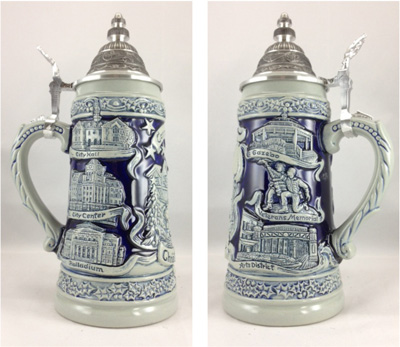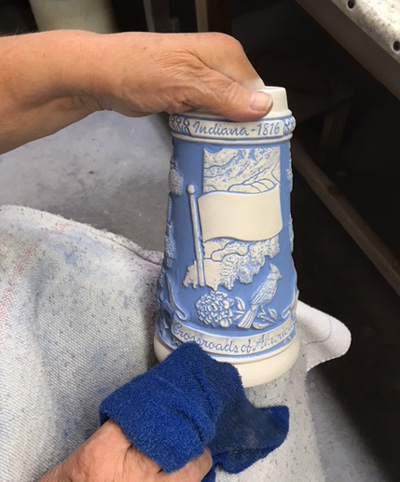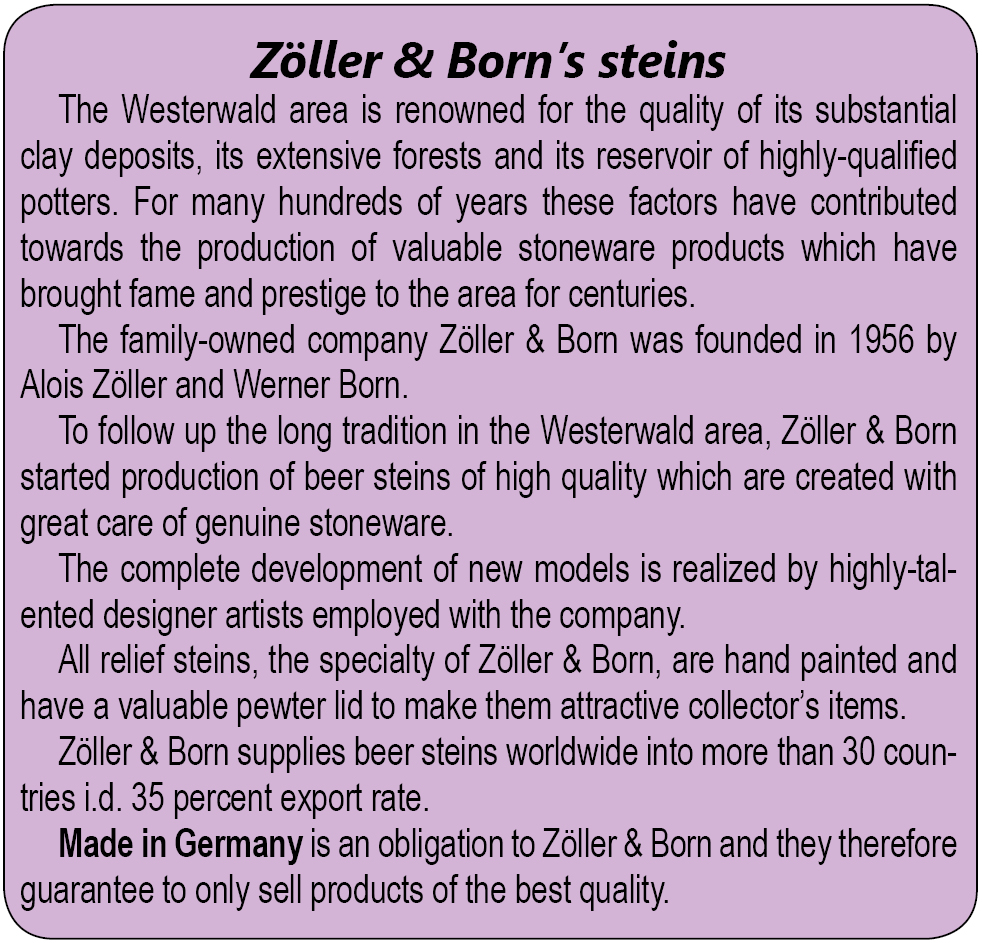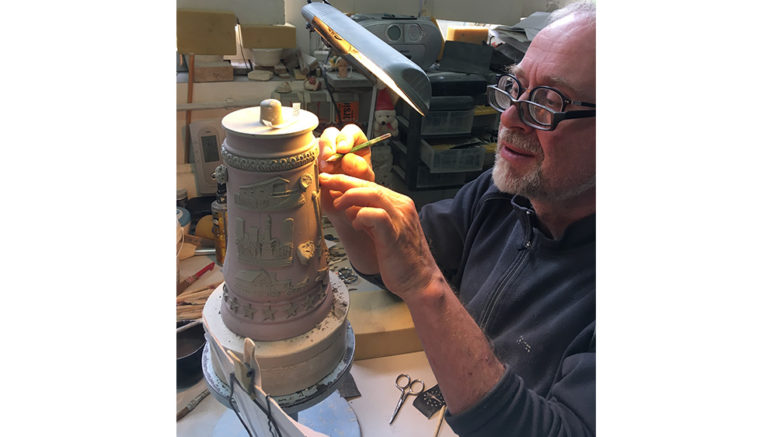For 20 years Carmel had an event called Holiday at the Square. Last year the event moved to Holiday at Center Green to be a part of Christkindlmarkt, a traditional German festival. And what German festival could be complete without ceramic beer steins?
When Christkindlmarkt CEO and Market Master Maria Murphy traveled to first Germany looking for authentic crafts items to sell at Carmel’s first Christkindlmarkt, she commissioned a limited-edition ceramic stein created by Zöller und Born in Hilscheid, Germany, with relief carvings celebrating the city and the festival. This year Murphy returned to Germany to commission a new stein for Christkindlmarkt, and The Reporter had the opportunity to talk to Herr Burkhard Zöller about the history of his craft.

The stein commemorating the City of Carmel and its first Christkindlmarkt will also be available for sale in limited numbers this year. (Photos provided)
Zöller’s steins are all bas-relief, a form of carving in which the images appear slightly raised from a flat background to give a three-dimensional effect to the art.
“The first stein we did for them was for the Carmel Christmas market,” Herr Zöller told The Reporter. “It was a relief of the Carmel Christmas market with different buildings in your city. And now, the second stein for this year is the brand-new relief stein for Indiana.”
Zöller explained the process for creating these hand-crafted steins usually involves working from photographs provided by the customer, which was also true for both Christkindlmarkt steins.
“Our master-sculptor, Deitmar, has been doing this job for about 40 years,” Zöller said. “When he gets the images from the customer he is able to model that into clay on a clay mold. All of what we are doing is done by hand initially. Everything is done here in our own factory. First of all, the molding. Preparing that. From this very first mold we make a mother mold. From this mother mold we are able to make a mold out of plastic. And from this plastic mold we can do the forms for manufacturing.”
Last year the Carmel stein was limited to a run of 400. This year’s Indiana stein will also be limited to 400 pieces.
“These 400 are split between four different colors,” Zöller explained. “It is always the same body – the same mold – and we do it in old blue, in a nature version that’s a little bit lighter, in a multi-colored version and in a rustic version. In each version we manufacture 100 pieces, so it is a very limited item. Carmel intends to also sell it for the next few years and the total edition will be limited to 5,000 worldwide.”

This year’s stein features Indiana iconography and landmarks. (Photo provided)
Zöller und Born has been in this business since the 1950s.
“My father and his partner founded the company in 1956 manufacturing beer steins,” Zöller said. “I was also founded in 1956, so I am as old as the company.”
Zöller und Born does not solely create limited-edition steins. They manufacture ceramic steins for various cities in Germany and throughout the world in sizes of 1/8 liter, 1/4 liter and 1/2 liter. The Carmel steins are limited editions to make them of interest to both Christkindlmarkt visitors and to collectors or ceramic art.
“There are only two small family-owned companies which are still manufacturing traditional hand-painted ceramic steins with the relief carvings here in Germany,” Zöller said. “Years before we had about 20 companies in the area. These relief steins are only manufactured in our area.”
The reason ceramic steins only coming from one area is due to the availability of the raw material, which only exists in the Westerwald. Thus the industry only exists there as well.
Ceramic manufacturing in the area goes back to circa 1850.
“In the past when beer was not in bottles like today, it was in big barrels,” Zöller said. “Fathers and grandfathers went themselves or sent their sons to an inn to put beer in a tankard. At home they would pour beer into these smaller half-liter sizes to drink it.”
 The use of ceramic for preserving temperature and freshness goes back to the time of the Romans.
The use of ceramic for preserving temperature and freshness goes back to the time of the Romans.
“You know perhaps from the old Romans if you have something in a ceramic item, it keeps it cold and fresh a long time,” Zöller said. “For example, if you put a ceramic stein into a refrigerator, after you take it out, you will have about two hours to enjoy a cold fresh beer because the ceramic keeps the coldness inside.”
Traditional ceramic steins have become an artistic specialty item as the world has moved to glass as an inexpensive alternative. Zöller told The Reporter that there were only several thousand ceramic steins used this year at the world’s largest Oktoberfest in Munich, Germany. It was because of the changing nature of the world market that Zöller und Born has shifted their focus to cater to the collectibles market.
That decision has kept his business alive when all but one other ceramic stein maker in Germany has closed. Thanks to that choice, this year’s Carmel Christkindlmarkt can offer visitors a traditional piece of German history and a limited-edition keepsake celebrating Indiana.
A total of 400 Indiana steins will be available at Carmel’s Christkindlmarkt for the first time anywhere in the world.
There is no gallery selected or the gallery was deleted.

